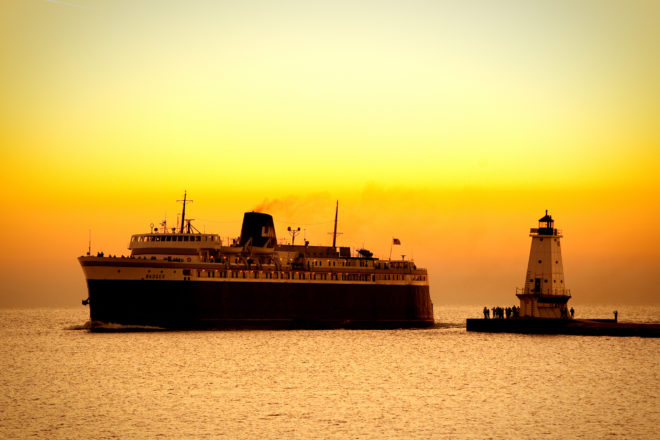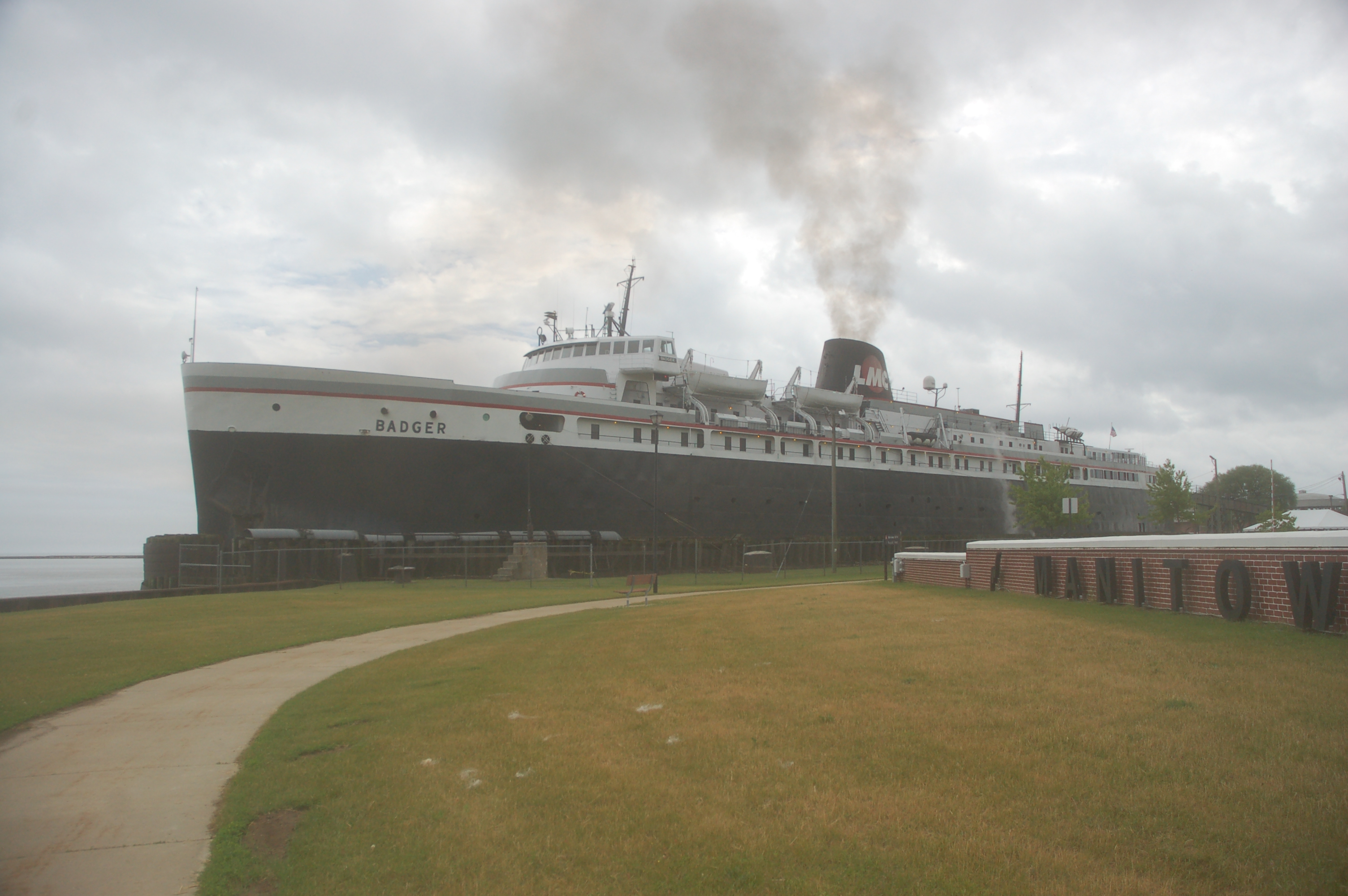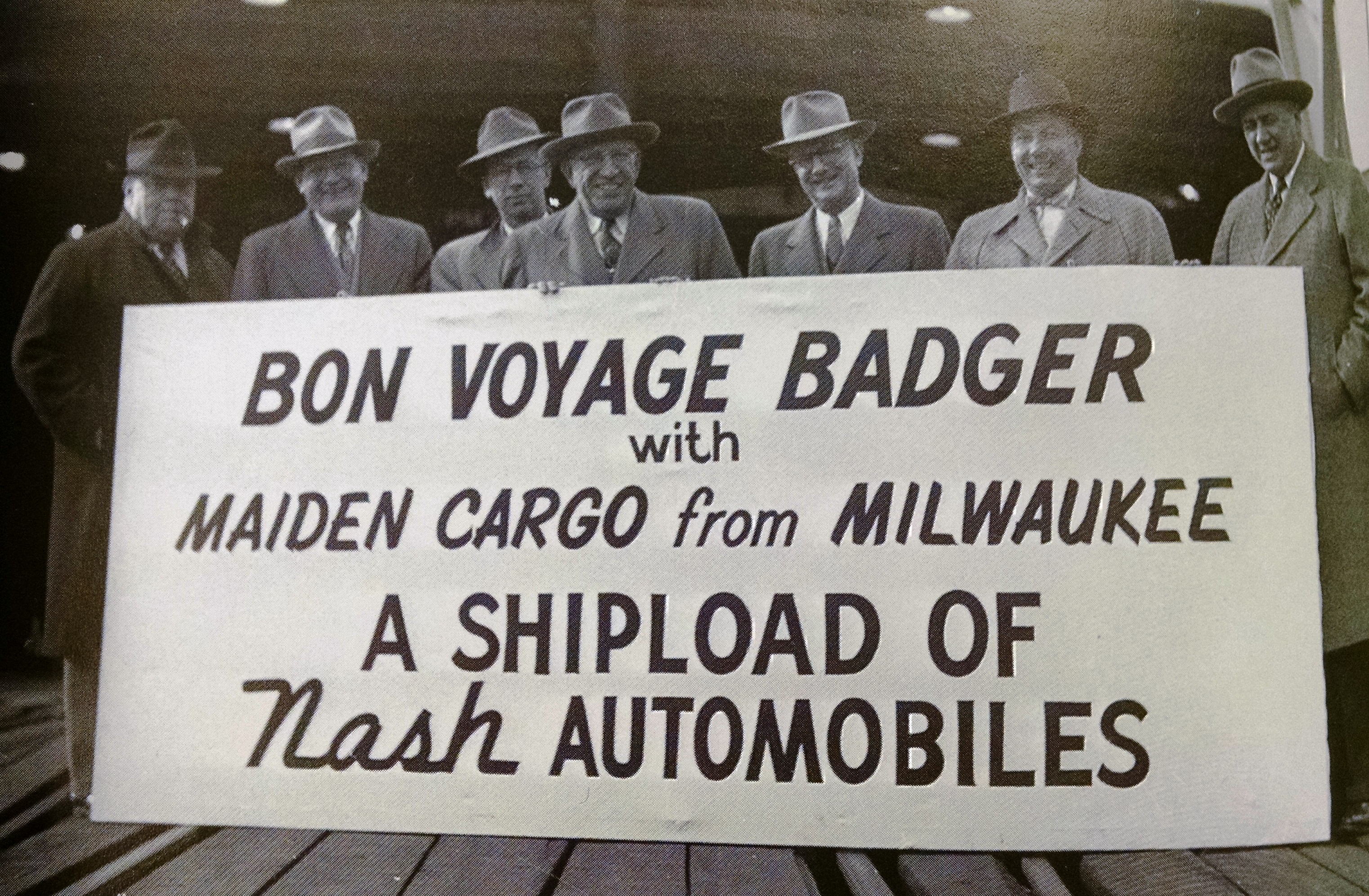SS Badger Began Life in Sturgeon Bay
- Share
- Tweet
- Pin
- Share

The fog in Manitowoc was proverbial pea soup thick the morning of June 18, when an official gathering was organized at the dock of the SS Badger. Gov. Scott Walker and various government officials were going to announce funding to repair the damaged 70-year-old sea wall and docking facility for the massive car ferry that runs between Manitowoc and Ludington, Mich.
But it appeared the fog would hide the Badger’s arrival, which was meant to be a visual prelude to the announcements from the officials.

Photo by Jim Lundstrom.
Then, just before its noon arrival, the veil of fog lifted and we were able to see the Badger back into its dock and unload its passengers before the official ceremony began to give details about the various governmental entities that came together to find money to repair the wall and dock for the only operating coal-fired car ferry in operation in the United States.
Several people, including Gov. Walker’s Director of External Relations Robert Schlaeger, wondered what in the world brought a reporter from Door County to this event.
Well, the SS Badger’s history is inextricably tied to Door County, and, more specifically, Sturgeon Bay, for that is where the Badger and her sister ship, the S.S. Spartan, named for the sports mascots of the university systems of Wisconsin and Michigan, respectively, were built and launched, at the Christy Corporation Shipyard, which today we know as Fincantieri Bay Shipbuilding.
“World’s Largest Car Ferries to Be Christened Here Saturday” read the Thursday, Sept. 4, 1952, page one headline of the Door County Advocate (the only local newspaper of the time). The pair of ferries, commissioned by the Chesapeake & Ohio Railroad to carry rail cars across Lake Michigan, were built for $5 million each (that’s about $46.5 million each in today’s dollars).
The two massive coal-burning steamships (hence the SS in their names) were built to be year-round carriers of railroad cars across Lake Michigan, but in the mid-1970s, owner C&O Railroad was not seeing a profitable future for car ferries and applied to the Interstate Commerce Commission to abandon the ferry routes. In 1979, the Spartan was docked in Ludington, where she remains today, still providing spare parts as needed for the Badger.
In 1990, it looked as though the Badger’s days were numbered as well when C&O shuttered the operation.
But entrepreneur and Ludington, Mich., native Charles Conrad hated to see the Badger idle, so he bought it and refurbished it for a car and passenger ferry service, which began operations in 1992 as the Lake Michigan Car Ferry Service. Conrad was involved in the operations until his death in 1995.
Manitowoc Mayor Justin Nickels opened the ceremonial groundbreaking for the bulkhead improvement project by mentioning that the state really came to the rescue just weeks before the shipping season was to begin in mid-May after an April blizzard hammered the road approach to the dock.
“The gales of April really hit us hard this year, especially on the dock wall,” Nickels said.
But thanks to $800,000 in emergency funds from the state, the repairs were made and the Badger was able to begin operations in May as scheduled.
 Nickels introduced the Governor as a major supporter of the Badger, and Walker said there are three very good reasons for being a supporter – commerce, tourism and transportation.
Nickels introduced the Governor as a major supporter of the Badger, and Walker said there are three very good reasons for being a supporter – commerce, tourism and transportation.
“And they all tie together,” he said. “From a transportation standpoint, some of that heavy freight stays off our roads and highways as long as they can. From an environmental standpoint it’s quite compelling because it takes some emissions down, and wear and tear on our roads.”
Being a coal burner, the Badger had its own environmental issue – namely enforcement action taken by the EPA that forced the car ferry company to find some other way to deal with the estimated 500 tons of coal ash created in the seasonal crossings rather than dumping it into Lake Michigan by the end of the 2014 shipping season.
The $2 million solution was an onboard ash collector. Once a week the ash is hauled to a plant on the Michigan side where cement products are made.
Lake Michigan Carferry President Bob Manglitz said it was a chore to bring the Badger into compliance, but doing so ushered in a prolonged life for the ferry service. He thanked the various branches of government for helping to keep the old ferry chugging away.
Others appearing included Congressman Glenn Grothman, Wisconsin Department of Transportation Secretary Dale Ross, and two members of the Foth Companies, which will perform the work on both the Manitowoc and Ludington docks, CEO Randy Homel and Client Manager Brian Hinrichs.
The Manitowoc work will include the installation of a 420-foot timber fender system and a sheet pile dock wall. The Ludington work will include the installation of a 260-foot timber fender wall system, along with renovation of existing mooring wall dolphins.

Photo by Jim Lundstrom.
Construction is scheduled to begin on both sides of the lake on Oct. 14 and be completed by May 10, allowing for the S.S. Badger to maintain its regular schedule.
The two ports received a federal FASTLANE (Fostering Advancements in Shipping and Transportation for the Long-Term Achievement of National Efficiencies) grant of $5 million (the original cost to build the S.S. Badger) for dock repairs. This highway grant applies to the Badger because in 2015 it was recognized as the continuation of U.S. Highway 10 between Michigan and Wisconsin. Only one other U.S. highway has a ferry-road connection – the Cape May-Lewes Ferry covers a 17-mile portion of the Delaware Bay, connecting U.S. Route 9 between Delaware and New Jersey.
The City of Manitowoc also will receive more than $3 million in the state’s Harbor Assistance Program (HAP) grants to help fund the construction.
WisDOT Secretary Ross, who previously served as mayor of the Lake Superior port city of Superior, praised the HAP grants for the assistance they provide for economic development in the state’s port cities, and had one other happy thought to share that only a former mayor might think of:
“One thing nice about waterways, they don’t have to be plowed and salted.”

